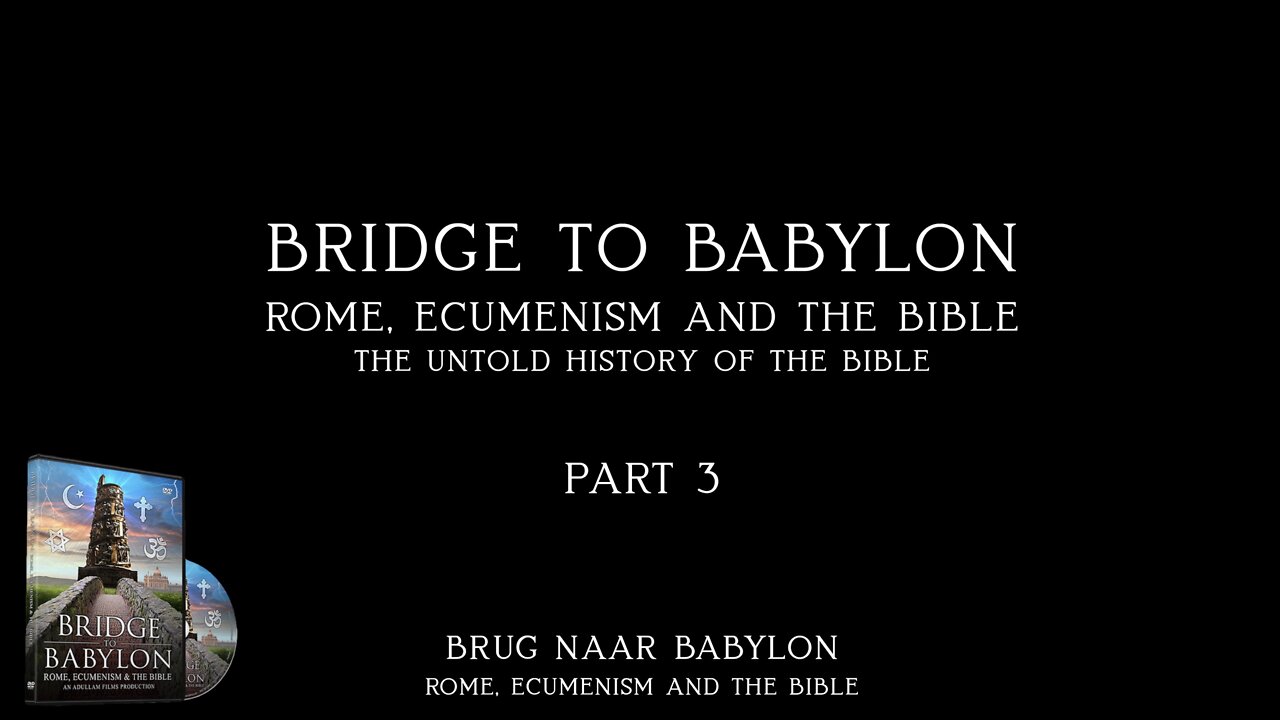Premium Only Content

Part 3 – The Untold History of the Bible – Bridge To Babylon – Rome, Ecumenism And The Bible
Bridge To Babylon – Rome, Ecumenism And The Bible
Follow the story of the Bible’s controversial history into the twentieth century, as the work of Westcott and Hort would transform biblical scholarship, inspire the work of various Bible Societies, and pave the way for the cause of ecumenical unity between Evangelical Protestants and Rome.
The new theory claimed that recently recovered manuscripts revealed a truer version of Scripture. Yet others warned that these manuscripts were, in fact, the creation of early Gnostic heretics that had been rightly abandoned centuries before. Was the new revision filled with ancient corruptions?
PART THREE IN THE UNTOLD HISTORY OF THE BIBLE DOCUMENTARY SERIES
The sequel to A LAMP IN THE DARK and TARES AMONG THE WHEAT
Featured Speakers: Dr. Phil Stringer, Dr. David Brown, David Daniels, Dr. D.A. Waite, Dr. Jack Moorman, Dr. Kirk DiVietro, Dr. H.D. Williams, Dr. Ronald Cooke & Dr. James R. White.
FILM SYNOPSIS
In 1881, two scholars named Westcott and Hort published a revision of the New Testament that would send shockwaves through the academic world. Their new textual theory declared that the King James Version (which had been trusted for centuries) was full of errors. Sacred readings, long cherished by the faithful, were now declared to be forgeries. The world was informed that the book, which had been called the inerrant Word of God, was in need of correction.
The new theory claimed that recently recovered manuscripts revealed a truer version of Scripture. Yet others warned that these manuscripts were, in fact, the creation of early Gnostic heretics that had been rightly abandoned centuries before. Was the new revision filled with ancient corruptions?
Follow the story of the Bible’s controversial history into the twentieth century, as the work of Westcott and Hort would transform biblical scholarship, inspire the work of various Bible Societies, and pave the way for the cause of ecumenical unity between Evangelical Protestants and Rome.
INFORMATION COVERED IN THIS DOCUMENTARY:
1) The history of the Revision of the Bible in 1881.
2) The objections of Dean John W. Burgon concerning the “new Greek text” invented by Anglican scholars, B.F. Westcott and F.J.A. Hort.
3) The analysis of George Sayles Bishop, R.L. Dabney and William G. Blaikie who likewise opposed the Revision of Westcott and Hort in the 19th century.
4) Proof that the purpose of the Revision was to overthrow the Received Text of the Protestant Reformation.
5) The warnings of Dr. F.H.A. Scrivener who declared that the theory behind the new Greek text was based on conjecture and fantasy.
6) The “Romish” doctrines of Westcott and Hort, as revealed in their letters, along with admissions of willful deception and heresy.
7) The warnings of early Church fathers concerning the corruptions of Gnostic heretics who altered ancient manuscripts in the early centuries.
8) Examples from the Critical Text of what are believed to be Gnostic influences that currently influence the majority of modern bibles.
9) How the work of Westcott and Hort was transformed into the Nestle-Aland Greek text, used by the vast majority of Bible colleges and universities, as well as most Bible translations.
10) The beliefs of Dr. Kurt Aland (the chief influence behind the Nestle-Aland Greek text) who denied the apostolic authorship of the New Testament, and suggested that Jesus may have been a mere “phantom.”
11) The influence of Dr. Bruce Metzger, a leading Bible critic of the 20th century (who worked on the RSV and NRSV translations) and his denial of the authorship of Moses in the Old Testament.
12) The influence of William Cameron Townsend, founder of Wycliffe Bible Translators, and Dr. Eugene Nida, father of the dynamic equivalence method of Bible translation (i.e. paraphrase).
13) The development of “bridge bibles” and what they mean.
14) The discovery of the Bodmer Papyri by a Jesuit priest.
15) Proof that the discovery of the Bodmer Papyri is associated with ancient Gnostic groups from the Nag Hammadi region of Egypt.
16) The influence of Rome, her Jesuits, and the ecumenical movement in the development of a single Greek text, as the “one world Bible” to unify all churches.
17) Discussion with Dr. James White (author of The King James Only Controversy) concerning his defense of the Critical Text and modern versions in general.
An Adullam Films Production
Written and Directed by: Christian J. Pinto
DVD Package Design by: Jeff Martens Designs
Copyright 2012 Adullam Films LLC
ALL RIGHTS RESERVED.
I have been given written permission to upload a foreign language version of the film by the Producer/Director. Adullam Films LLC
-
 3:55:04
3:55:04
ThatStarWarsGirl
12 hours agoTSWG LIVE: Big NEWS! Plus Reacting to Woke Meltdowns!
115K23 -
 8:02:46
8:02:46
FusedAegisTV
13 hours ago『AST lvl 100』Tuesday Raid & Rant | Final Fantasy XIV | Patch 7.1 Day of Reckoning!
78.4K2 -
 59:17
59:17
Matt Kohrs
14 hours agoRumble's Q3 Recap & What's Next w/ CEO Chris Pavlovski
97.9K30 -
 1:43:47
1:43:47
Adam Does Movies
18 hours ago $29.08 earnedGladiator II Early Reviews + Tom Cruise Stans Glen Powell + Freddy Krueger - Movie News LIVE!
88.4K3 -
 2:24:03
2:24:03
WeAreChange
14 hours agoTrump Creates Department Of Government Efficiency With Elon And Vivek!
146K102 -
 2:10:32
2:10:32
Slightly Offensive
16 hours ago $31.81 earnedGET READY: Civil Unrests ERUPTS As Trump Resistance 2.0 EMERGES
82.9K91 -
 59:40
59:40
The StoneZONE with Roger Stone
12 hours agoShowdown in the Republican US Senate Caucus - RINOs Seek to Undermine Trump | The StoneZONE
78.2K45 -
 1:26:29
1:26:29
I_Came_With_Fire_Podcast
17 hours agoSpecial Episode: Frank Luna with Smokeless Vets
49.2K3 -
 4:16:31
4:16:31
Tundra Gaming Live
13 hours ago $1.99 earnedFormer Air Force Maintainer (Weapons) Hits The Grind For The F-16c
32.8K1 -
 1:07:06
1:07:06
The Officer Tatum
14 hours agoLIVE MSNBC, CNN IMPLODE As Trump BUILDS DREAM TEAM!
95K201